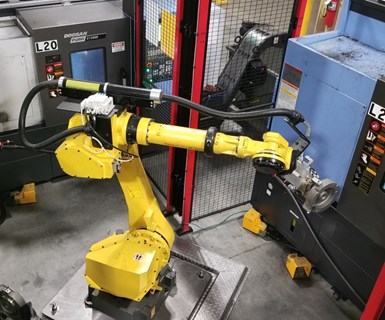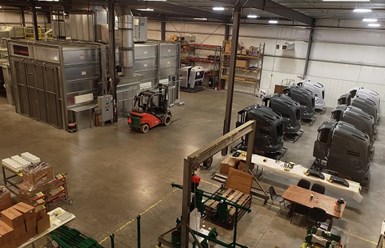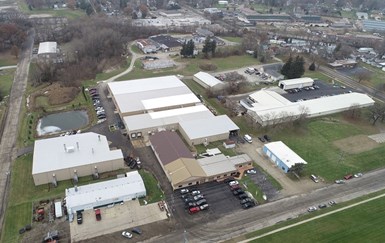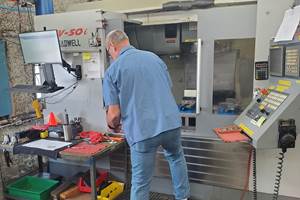ERP Leads CNC Machine Shop to Adopt a Paperless Initiative
Enterprise resource planning software is not only enabling Chapter 2 to better manage its range of capabilities, but also to help it go paperless.
Share





Chapter 2 has added two robotic machining cells like this one to machine flywheels for small engines.
Amanda Johnston, marketing specialist for Chapter 2 Inc., says the contract manufacturer has expanded and implemented a number of changes to become more efficient since it was named a Top Shops winner in 2015.
The Lake Mills, Wisconsin, company has a range of in-house manufacturing capabilities including CNC machining, welding, assembly and painting, as well as workholding-device and tool-and-die manufacturing. In the last five years, it has added a wealth of new capital equipment. This includes turning centers, horizontal machining centers, a new side-down-draft paint booth, urethane molding process and coordinate measuring machine (CMM). It has also expanded its facility by 20,000 square feet, bringing total floor space to 100,000 square feet.
The shop also has added two robots to create two cells producing flywheels for small engines. Each cell features two CNC lathes. This enables one person to tend two machines, whereas before adding the robots, one person for each of the four machines was required. The cells increase throughput and also eliminate the repetitive motions formerly required of these employees to maneuver 20-pound workpieces by hand.
Chapter 2 has also made significant changes on the software side of things. It moved away from basic accounting software to an enterprise resource planning (ERP) system in 2016. The issue with the accounting software is that it lacked work order and shopfloor control capabilities that the company felt it needed. That software worked fine for inventory management, but had no job tracking capabilities. Plus, one part number could have a variety of spreadsheets tied to it. All this was exacerbated given that the shop had so many different manufacturing departments through which a job might run.
With ERP, all job information is tracked in one place, and the shop can easily see the status of every job on the shop floor.
Since adding the ERP system, all job information is tracked in one place, and the shop can easily see the status of every job on the shop floor. “It also has eliminated a lot of paper use, as employees used to hand in a printed timecard at the end of the day where they listed what jobs they ran, how many parts were produced, run time and so on,” Ms. Johnston says. “Now, the ERP system captures all the information for us when employees log in to a job within the system.”

ERP is especially helpful for tracking jobs at Chapter 2, given that the shop has so many different manufacturing departments jobs might run through. Here is the shop’s paint department.
Chapter 2 has also developed its own computer application, which has further reduced its reliance on paper documentation. “Previously, we printed hard copies of all work instructions and inspection logs that employees then filled out by hand at the end of their shift,” she explains. “Those logs were then filed in cabinets and stored. Today, employees use our app, and all that information is stored in a database.”

Chapter 2’s recent facility addition brought total floor space to 100,000 square feet.
The first job for which Chapter 2 chose to implement this paperless process was the flywheel part mentioned above, a job that required a number of inspection logs. The process is also helpful when employees’ time is split between multiple jobs by allowing for a more effective means of tracking true labor cost for each job. In addition, the process acts as a customer service tool. For example, if a customer were to call asking for immediate delivery of parts for a given job, a manager could see how many parts for that job have been completed and could be delivered. It would also be easy to provide a good estimation of delivery time for the remaining parts.
This aligns with Top Shops benchmarking results over the course of the survey’s 10 editions. Successful shops are more likely to have an ERP system than lower-performing shops. And those that participated in this year’s survey, our tenth edition, should be getting their custom reports soon. If you didn’t participate this year but are interested in survey results, visit gardnerintelligence.com.
Related Content
CNC Machine Shop Honored for Automation, Machine Monitoring
From cobots to machine monitoring, this Top Shop honoree shows that machining technology is about more than the machine tool.
Read More2024 Top Shops Honorees Announced
Modern Machine Shop Recognizes Excellence in Manufacturing with Annual Award
Read MoreJob Shops Can’t Do Everything, And That’s OK
Deciding to narrow down its jobs and customers was a turning point for 2023 Top Shops Business Strategies honoree Manda Machine that has led to improvements in the front office and on the shop floor.
Read MoreSame Headcount, Double the Sales: Successful Job Shop Automation
Doubling sales requires more than just robots. Pro Products’ staff works in tandem with robots, performing inspection and other value-added activities.
Read MoreRead Next
ERP Software Enables Paperless Manufacturing
Smart Manufacturing Experience 2018: Kairos Manufacturing Solutions, reseller of ProShop software from Adion Systems, will be sharing insights into the benefits and value of ERP for manufacturing management.
Read MoreERP Software Improves Aerospace Shop’s Operational Efficiency
Talsco Manufacturing Inc. improved its operational efficiency by implementing new ERP modules from Realtrac.
Read More



























.jpg;maxWidth=300;quality=90)






